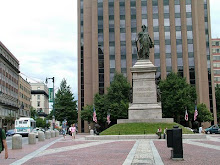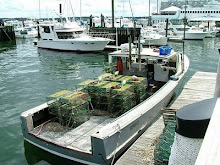
What do you get when you mix
2 - 15 oz cans of garbanzo beans
2-3 cloves of garlic
1/2 cup of tahini
One jar of roasted red peppers
2 tablespoons of olive oil
1 1/2 teaspoons of salt
1/3 cup of lemon juice
and
several good friends all with an appetite for a certain Mediterranean food?
You get a hummus party, of course!
Due to the sad demise of the brand of hummus I had been eating that suddenly changed its recipe, I decided to see what it would be like to make my own hummus. Everyone and their brother, and their brother's brother, told me how easy it was to make hummus. 10 minutes and you're done, they said!
Lesson One: Don't listen to other people. :)
Luckily, I had some trusty sidekicks to help me. Jeanine and Amber were my co-chefs, while Nate and Rob provided support in the eating department. :)
First, it simply took a long time to get all the numerous ingredients out of the shopping bag, on to the table and opened. Either we were particularly slow or they don't include that in the prep time. None of us had ever done this before, so we had little idea of what we were doing.

We added all the ingredients to the food proccessor, pressed on, and then were faced with a bitter truth of hummus making:
Lesson Two: They don't tell you that the hardest part of making hummus is putting up with the noise of the food processor.
Probably because "they" aren't a bunch of Aspies trying to form sustenance.


Bravely, however, we plowed on. First taste revealed a way too thin and way too lemony concoction, so we tempered that with more beans and some red peppers. After another half hour or so of tinkering and having gone nearly deaf, we pronounced it good. A little on the spicy part for me, as the garlic packed a punch, but good. Definitely edible, which is all I was really looking for in the first place. Overall, a success.
We transfered it to its resting place in the fridge and adorned it with a rosemary twig.

On to batch 2, which we decided to make basil flavored. I had fresh organic basil to use, which undoubtably improved the flavor, that is, of course, after we got finished doing the 102 adjustments that were needed before putting the basil in.
Lesson Three: Aspies can get kind of overwhelmed with making decisions. And when you make hummus, you have to make a lot of decisions.
We were dropping like flies by the time we approached the third batch, but we, or at least I, perked up a little bit when it came to adding the seasoning. A bunch of fresh rosemary. Vroom! Vroom! went the engine of doom. Off went the top as we bravely sampled the wares. Nothing. It tasted like nothing. "Okay, take that, you evil hummus monster!" I said, and grabbed the container of dried rosemary, shoving liberal amounts into the top of the hummus. "How much are you going to add?" asked Janice, who was the practical one. "A lot," I said, giving an ever so scientific and precise answer.
"Vroom! Vroom!" went the machine. Clank! Clank! went the spoons as they scooped yet another helping from its plastic insides. But alas, there was still no taste, so I dumped almost the entire conents of a package of dried lavender in and said, "Aha! Now you will taste like something!"
Lesson Four: Just because something tastes good by itself does not mean it will work in hummus.
Batch #4 was a milder and less spicy version of the red pepper.
After everyone had had a taste of all four batches, and admired how pretty they were, we gave up on the cooking thing and went to watch a movie (My Name is Kahn).
Lesson Five: Everything is more fun with friends, even something that would be tedious and completely overwhelming alone.
Lesson Six: It feels really good to have someone else enjoy something you made - maybe even better than enjoying it yourself.
Everyone left with a portion of the hummus in a nifty disposable Tupperware container provided by Rob.
The hummus still might not be as good as what I used to buy in the store, and I am still hoping the hummus I ordered from Brunswick is a decent substitute, but it was a fun and educational thing to do once. I know how to make my very own hummus if I ever get into a pinch. One can never have too many skills, especially when it comes to cooking.

Happy hummus eating!








